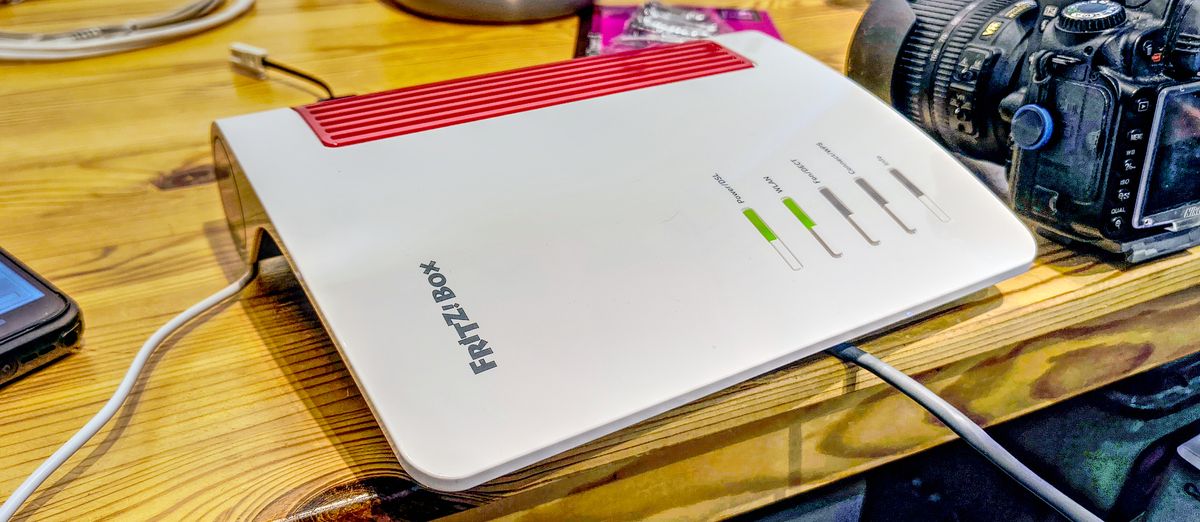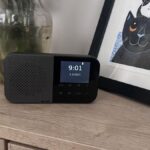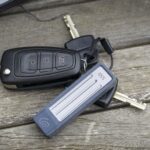FRITZ!Box 7690: 30-second review
The AVM FRITZ!Box brand enjoys widespread recognition in Europe yet remains a lower-profile brand in other regions. AVM has established itself as a maker of reliable, high-quality products that prioritise performance over superficial design.
It’s been a long eight years since the FRITZ!Box 7590 AX and AVM have now launched a new model that looks oddly similar, the 7690.
This FRITZ!Box router maintains the styling of their predecessors but with entirely new internal electronics that now support a 4×4 antenna array and WiFi 7 communications.
In addition, the wired networking has also been revamped with a 2.5GbE WAN port, making this router ideal for a wide range of broadband scenarios with connections over 1GbE.
And, for those who do not have access to fibre, an inbuilt ADSL2+ modem can get you connected quickly.
Other features include support for DECT phones, Smart home networking, Zigbee networking, and even analogue telephony.
Overall, this isn’t the cheapest way to add WiFi 7 to a network, but it offers most of the bells and whistles considered good in a business environment. However, without 6GHz support, it doesn’t provide the whole WiFi 7 experience for those who can use those bands.
As with all FRITZ!Box hardware, the 7690 is an elegant tool with a wide feature set linked to a good support network. However, these aspects might not justify the price if they are technologies you don’t intend to use.
This router is probably more attractive to home users, and as a result, it might not make it into our best business router selection.
FRITZ!Box 7690: Price and availability
- How much does it cost? £334/€264
- When is it out? Available now in Europe
- Where can you get it? You can get it from Amazon and many other online retailers.
As routers made for both home and business users go, the AVM FRITZ!Box 7690 isn’t overly expensive, but it is a bargain, either.
The cost in the UK is £333.67 through Amazon.co.uk, which is supplied directly from AVM, though it may be possible to get it cheaper from other sources.
One of those cheaper options is to get it from Germany, where it sells for only €263.99 on Amazon.de. But be careful because this is a German version of the router, and the cabling supplied for telephone connections may not work in your region.
It’s slightly more expensive in other EU countries, being around €310, typically.
At the time of writing, FRITZ!Box 7690 isn’t listed on American Amazon.com, although other products from this brand are sold at this outlet.
FRITZ!Box 7690: Specs
|
Feature |
Spec |
|---|---|
|
Model: |
FRITZ!Box 7690 International version |
|
2.4GHz: |
4×4 up to 1376 Mbit/s (20/40MHz) |
|
5GHz: |
4×4 up to 5760 Mbit/s (20/40/80/160MHz) |
|
6GHz: |
N/A |
|
Ports: |
1 x DSL (ASDL2+, supervectoring)1 x 2.5GbE WAN1 x 2.5GbE LAN2x 1GbE LAN1 x USB 2.0 1 x Reset button2 x RJ11 DECT Phone |
|
Mesh: |
Yes |
|
MLO |
Yes |
|
AFC |
No (no 6GHz) |
|
Wired Link Aggregation |
No |
|
Modes |
Router Mode, Access Point Mode |
|
Firmware: |
FRITZ!OS 8.02 |
|
Dimensions: |
254 x 63 x 191 mm |
|
Weight: |
600g |
FRITZ!Box 7690: Design
- Retro styling with enclosed antenna
- 2.5GbE WAN and LAN
- 802.11be choices
While the FRITZ!Box routers’ retro styling might irk some, but it’s preferable to some of the more extreme ‘spiders from Mars’ aesthetics that some brands favour. It’s also nice that it uses a fully enclosed antenna array, making the device easier to wall-mount and less obvious.
Compared to the prior 7590 AX, the outside of the 7690 is almost identical, although some ports have enhanced specifications. All the significant changes are inside, with a massive revision of the wireless services offered and the broadband services this router is meant to interact.
One external change is that the ethernet port layout has been completely revised. In the 7590 AX there were five ethernet ports split into one WAN and four LAN, and these all had a specification of 1GbE. In the new 7690, there are only four ports in total, split into a single 2.5GbE WAN, a single 2.5GbE LAN and two 1GbE LANs.
The loss of a port is meant to be offset by the higher speeds on offer, but only three LAN ports seem to be limiting, and there is no support for link aggregation of these ports.
It also caps the highest broadband speed at 2.5GbE, a performance level likely to be overtaken in the next year for some regions.
While a step up from the 7590 AX and many other routers, the WAN/LAN options on this router don’t provide much in the way of future-proofing.
And, the irony of the WiFi 7 in this technology is that it can distribute more data over wireless connections than it can over Ethernet. Surely, LAN should be faster than the WiFi?
According to my calculations, this router should be designated as a BE7200 class device, although I didn’t find this rating in any of its documentation.
What’s interesting is to compare this router with a cheaper WiFi 7 one from a competitor, like one from Asus.
FRITZ!Box went with a dual-band configuration and put all its eggs in the 5GHz basket, while the Asus RT-BE92U is a Tri-band design, with most of the bandwidth allocated to 6GHz and only 2882Mbps on 5GHz. On paper, the Asus router is BE9700, implying a much greater bandwidth if you can use these channels and have adapters that can access them.
Therefore, the 7690 is one of the more conservative WiFi 7 offerings, but perhaps it’s just being more realistic.
Design score: 3.5/5
FRITZ!Box 7690: In use
- Web or phone app interface
- No bridging or link aggregation
- Fritz!OS Apps
What’s nice about FRITZ!Box technology is that you are not forced to use a mobile application to initially configure the router, as the web interface is available either over wired or wireless networking. Once the system is up and running, it can be connected to a cloud service to provide remote monitoring and access, but again, this isn’t mandatory.
Depending on which of the special features of this device you want to use, additional configuration is required beyond getting a WiFi service that links systems to the Internet.
The web interface isn’t as elegant as some I’ve seen, but it is absolutely packaged with features that allow remarkably granular control over users, services and security.
It shares with the previous 7590 AX that phone connections can be run using DECT through the router without having a specific landline as part of your connection package. This works regardless of whether you are using a cable modem and the WAN port or the inbuilt DSL modem.
As a UK cable customer, I still have the same house phone number that I’ve always had, but no RJ11 wiring around the house or a monthly phone line charge. How useful this might be in other countries, I’m unsure, but in many European locations it’s the way that home telephony has gone.
Another development also orientated to home users is that this router embraces Smart home technologies, like HomeAssistant, and with this hardware FRITZ!Box has included the Zigbee networking standard as a default feature.
Zigbee is a low-power 2.4GHz network protocol designed for IoT devices like smart switches and lightbulbs. It allows up to forty devices to be easily linked to the network and then controlled by Alexa, Google Home, or smart operating systems like HomeAssistant.
While businesses are somewhat slow on the uptake of this technology, it’s becoming increasingly popular with home users. What might boost business interest is that FRITZ!Box has promised that it will also be supporting the Matter protocol standard via a firmware update, but when this will arrive isn’t clear.
These features elevate the 7690 from being a WiFi 7 router to making it the hub of a smart home (or business), where a myriad of control technology and services can be centrally managed.
It could be better with link aggregation on the LAN ports, and the router only operates as an Access Point or as a Router; it doesn’t support being a bridge. That last aspect is less common these days, mostly due to security concerns, but it’s worth knowing what this hardware can and cannot do.
One place where the 7690 goes above and beyond is the FRITZ!Box applications for Android and iOS. Where most router brands have software apps to control the router from a phone or tablet, but there isn’t just one app, but a suite of genuinely useful tools.
These include FRITZ!App Fon, a tool to answer and make landline calls via the router, and FRITZ!App TV that enables unencrypted cable TV to be watched on your phone. How useful these are will depend on your broadband circumstances, and they’re not meant for business use but more than most router makers are supplying.
FRITZ!Box 7690: Performance
When comparing the WiFi performance of the prior 7590 AX, one might assume that as these are both 4×4 antenna routers, the bandwidth would be largely similar.
However, the 7590 AX was an AC2400 class design, with a maximum theoretical throughput of 1733 + 800 Mbit/s using both 5GHz and 2.4GHz bands.
The new 7690 uses a WiFi 7 arrangement where multiple parts of the same bands can be aggregated to increase the flow of data substantially. With this functionality, up to 1376 Mbit/s can be extracted from the 2.4GHz channels, and a massive 5760 Mbit/s can be extracted from the 5GHz range.
There are two caveats to this wireless aggregation, the first being that it assumes that these bands aren’t already used by other networks, possibly from other local WiFi hardware or bleed from adjoining businesses or homes.
This was certainly something that heavily impacted my testing since other WiFi hardware, DECT phones, and other independent 2.4GHz devices curbed the best speeds significantly.
As a result, the fastest connection I managed using a Comfast WiFi 7 USB adapter was 2,882 Mbit/s up and down using 2x in each direction, well below the theoretical peak.
The other missing piece of this puzzle is that WiFi 7 can use the 6GHz range, but the 7690 does not support this third frequency range.
While I’ve included this as one of the limitations of this hardware, in the UK, relatively little of the 6GHz range is available for home or business users to access since the MOD, among others, was allowed to use it a long time ago.
I’m not sure what value a frequency with such a short practical range is to those services, but until 6GHz is cleared for use, it’s of extremely limited value in some regions and, therefore not a massive drawback that this hardware doesn’t support it.
The more significant issue here is most certainly the overlaps from other wireless users, and the further away you travel from the router, reducing the 5GHz slice of the bandwidth pie, it seems less useful.
Even if you turn off every other wireless source in the building, including DECT phones and even the Zigbee signals that the router generates, and get your neighbours to cooperate by not blanketing all the channels, the highest quoted speeds are only possible at remarkably short ranges. These are ranges where an Ethernet cable could be easily connected.
In my tests, walking to the next room only 5 metres away resulted in a performance drop to 1,729 down and 1,153 Mbit up. But what’s most confusing is that by reverting from the Comfast WiFi 7 adapter to the Intel AX201 WiFi 6 adapter on the laptop, I was able to get faster speeds at this range. The theoretical peak was lower, at just 2,402Mbit/s in both up and down, but the speeds were higher.
This demonstrates that in a congested environment, WiFi 7 isn’t always the best approach.
What I’m not saying here is that the FRITZ!!Box 7690 isn’t a good WiFi 7 router. I’m just pointing out that, unlike an Ethernet cable, mileage will vary, and what’s great in one situation (physically isolated property) might be less desirable. And, my location took away many of the advantages of this hardware, probably unfairly.
This hardware is definitely for those sites where wireless networking can be strategically controlled and not just lumped in with lots of other brand hardware that wasn’t designed to work together.
FRITZ!Box 7690: Final verdict
I have two issues with the FRITZ!Box 7690, and neither of them is the retro styling.
My first issue is that this router wants to be all things to all potential customers, and while spreading the net wide is always a sound strategy, it leaves the two potential customer bases paying for features they might never use.
For home users, the inclusion of analogue telephony interfaces to connect to an exchange is irrelevant, and conversely, the majority of business users won’t care about Zigbee devices.
It’s 2025, and hardware makers shouldn’t be encouraging businesses to still have fax machines so they can turn perfectly legible documents into low-resolution junk using a massively inefficient technological throwback to the 1980s.
Maybe FRITZ!Box doesn’t want to be the people to tell their ageing customers that the Fax and the analogue phone exchange went the way of the Dodo decades ago, but it’s high time someone did.
My second problem with FRITZ!Box 7690 is the time that passed since the prior design and how long it might be before the 7690 is superseded. Even if the 7790 model comes along in five years, the wired networking on the 7690 will be out of date well before then.
Fibre broadband providers are looking to offer 5GbE and even 10GbE to home users in the next couple of years, but at this point, the 7690 isn’t suitable for distributing those connections.
What FRITZ!Box needed was a router with SFP+ module support so that it could be supplied with 2.5GbE WAN and LAN but upgraded to 5GbE or 10GbE when required.
If the upgrades to this router line don’t come along as often, then longevity needs to be maximised. While the 7690 is an excellent piece of hardware today, it might be less impressive two years from now.
With products like the previously mentioned Netgear Nighthawk RS300 priced at £259.99 in the UK and $279.99 in the USA, that offers up to 9.3Gbps of wireless bandwidth and an extra 2.5GbE LAN port, the FRITZ!Box 7690 must be cheaper, even if it offers some features that the RS300 and others can’t match.
Should I buy a FRITZ!Box 7690?
|
Attributes |
Notes |
Rating |
|---|---|---|
|
Value |
Not cheap but acceptable value for the features |
3.5/5 |
|
Design |
Retro styling but it could do with more LAN ports. |
3.5/5 |
|
In Use |
Easy to configure and feature rich |
4/5 |
|
Performance |
WiFi 7 is wonderful but not everywhere |
4/5 |
|
Overall |
A classy router, but lacks future-proofing |
4/5 |
Buy it if…
Don’t buy it if…
For more hardware, we’ve reviewed the best mesh Wi-Fi systems and the best WiFi routers.
Read the full article here












